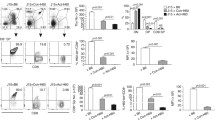Abstract
THE normal development of T cells in the thymus requires both positive and negative selection. During positive selection, thymocytes mature only if their T-cell receptors react with some specificity to host major histocompatibility complex (MHC) and host peptides. During negative selection, thymocytes die if their T-cell receptors react with too high an affinity to the presenting cell, self MHC, and peptides to which they are exposed. These two processes are important for the development of the T-cell repertoire and the acquisition of self-tolerance, but their precise location and temporal relationship are not known. We have used the keratin 14 (K14) promoter to re-express a class II MHC antigen (I-Ab) in class II-negative mice. The transgenic I-A molecule is expressed only on thymic cortical epithelium; thymic medullary epithelium and bone-marrow-derived cells are I-A negative. CD4+ cells are positively selected in K14 mice, but clonal deletion does not occur in K14 mice or in relB-negative mice, which lack a thymic medulla. The K14 CD4 cells are autoreactive, as they proliferate extensively to and specifically lyse I-Ab-positive target cells. These autoreactive cells make up 5% of the peripheral CD4 T cells, providing an estimate of the minimal frequency of positively selected cells that must subsequently undergo negative selection for self-tolerance to be preserved. Thus positive and negative selection occur in anatomically distinct sites.
Similar content being viewed by others
References
Vassar, R. & Fuchs, E. Genes Dev. 5, 714–727 (1991).
Widera, G. et al. Cell 51, 175–187 (1987).
van Ewijk, W. et al. Cell 53, 357–370 (1988).
Braunstein, N. S., Germain, R. N., Loney, K. & Berkowitz, N. J. Immunol. 145, 1635–1645 (1990).
Grusby, M. J., Johnson, R. S., Papaioannou, V. E. & Glimcher, L. H. Science 253, 1417–1420 (1991).
Cosgrove, D. et al. Cell 66, 1051–1066 (1991).
Burkly, L. et al. Nature 373, 531–536 (1995).
Glimcher, L. H., Longo, D. L., Green, I. & Schwartz, R. H. J. Exp. Med. 154, 1652–1670 (1981).
White, J. et al. Cell 56, 27–35 (1989).
Berg, L. J., de St. Groth, B. F., Pullen, A. M. & Davis, M. M. Nature 340, 559–562 (1989).
Murphy, D. B. et al. Nature 338, 765–768 (1989).
Dighe, A. S. et al. Immunity 3, 657–666 (1995).
Burkly, L. C. et al. J. Immunol. 151, 3954–3960 (1993).
Surh, C. D. & Sprent, J. Nature 372, 100–103 (1994).
Ignatowicz, L., Kappler, J. & Marrack, P. Cell 84, 521–529 (1996).
Miyazaki, T. et al. Cell 84, 531–541 (1996).
Cosgrove, D., Chan, S. H., Waltzinger, C., Benoist, C. & Mathis, D. Int. Immunol. 4, 707–710 (1992).
Berg, L. J. et al. Cell 58, 1035–1046 (1989).
Anderson, G., Owen, J. J., Moore, N. C. & Jenkinson, E. J. J. Exp. Med. 179, 2027–2031 (1994).
Poirier, G., Lo, D., Reilly, C. R. & Kaye, J. Immunity 1, 385–391 (1994).
Hoffman, M. W., Heath, W. R., Ruschmeyer, D. & Miller, J. F. Proc. Natl Acad. Sci. USA 92, 9851–9855 (1995).
Murphy, K. M., Heimberger, A. B. & Loh, D. Y. Science 250, 1720–1723 (1990).
Hengartner, H. et al. Nature 336, 388–390 (1988).
Taswell, C. J. Immunol. 126, 1614–1619 (1981).
Author information
Authors and Affiliations
Rights and permissions
About this article
Cite this article
Laufer, T., DeKoning, J., Markowitz, J. et al. Unopposed positive selection and autoreactivity in mice expressing class II MHC only on thymic cortex. Nature 383, 81–85 (1996). https://doi.org/10.1038/383081a0
Received:
Accepted:
Issue Date:
DOI: https://doi.org/10.1038/383081a0
- Springer Nature Limited
This article is cited by
-
IL-2 and IL-15 dependent thymic development of Foxp3-expressing regulatory T lymphocytes
Protein & Cell (2017)
-
TCR affinity for thymoproteasome-dependent positively selecting peptides conditions antigen responsiveness in CD8+ T cells
Nature Immunology (2015)
-
Conventional CD4+ T cells regulate IL-22-producing intestinal innate lymphoid cells
Mucosal Immunology (2014)
-
Clonal deletion and the fate of autoreactive thymocytes that survive negative selection
Nature Immunology (2012)
-
How to find your way through the thymus: a practical guide for aspiring T cells
Cellular and Molecular Life Sciences (2012)





